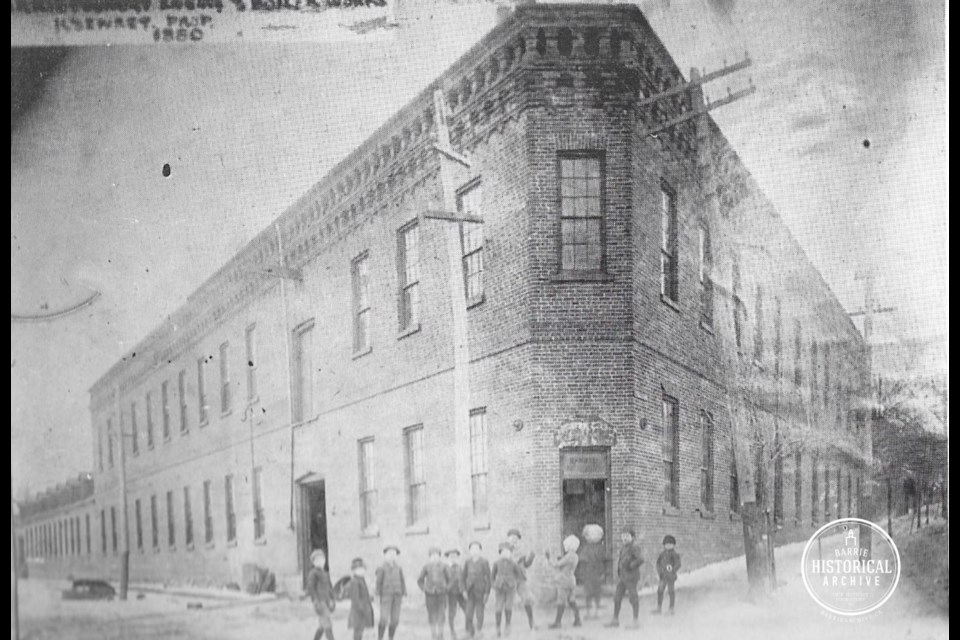Frank Sanders beat all the odds and passed away peacefully in a warm bed at Barrie’s Grove Park Home at the wonderful age of 96 years.
Frank was the son of a lace maker, born in Bobber’s Mill, England, which is today a suburb of Nottingham on the edge of the famed Sherwood Forest. In 1909, Frank immigrated to Canada and worked for a time as a miner.
Three years later, he arrived in Barrie and found himself a bride, an English émigré like himself, Esther Mason. The young couple’s first home was at 265 Dunlop St. E. and they shared it with their little son, Alfred.
Frank Sanders was employed at the Dyment Foundry, the imposing brick foundry built by Henry Sewrey that once dominated the corner of Bayfield and Ross streets, where a tiny drive-thru Tim Horton’s sits today.
The Sanders family was barely established in this town when war began overseas. In June 1915, Frank enlisted. As a former Sherwood Forester back home, he would be a good fit for the 35th Regiment of the Simcoe Foresters here.
Frank’s unit sailed for Europe in November 1915 aboard the S.S. Lapland. As was common, units were merged and reformed as deemed necessary by military commanders, and Frank found himself in the 3rd Canadian Tunnelling Company by 1916. His mining experience would become handy.
Hand shovelling in close quarters couldn’t have been easy. The risks included possible carbon monoxide poisoning, tunnel collapse and the ever-present risk that the mines they were laying might prematurely explode.
In the summer heat of 1916, Frank Sanders was involved in tunneling just south of Ypres in Belgium. The location was Hill 60, an objective so hard fought and famous that my father and his cousins played Hill 60 war games together as children in the 1930s.
On Aug. 30, Frank collapsed. He spent two months in various field hospitals suffering from what was termed myalgia. In other words, severe muscle pain. The tunneller had worn his body out.
Since 1915, the Germans had been trying to find a way to break the stalemate of trench warfare. They first released greenish yellow chlorine gas in April of that year at Ypres which horrified the enemy, but it also had the potential to inflict injury on their own soldiers if the wind changed direction.
The next step was the shell which could be launched from a safe distance into Allied territory. In February 1918, one of them, filled with mustard gas, landed near Frank Sanders.
This nasty chemical blisters the skin, damages the respiratory tract as well as the digestive system, and can cause blindness and permanent disfigurement and disability.
Frank Sanders’ medical report tells us that he experienced headaches, muscular weakness, rapid pulse, shortness of breath and stomach troubles. He spent 4 months in hospital and 6 more attempting to be fit enough to continue serving.
Finally, on Christmas Eve 1918, Frank was officially discharged after being found medically unfit. At that time, he was still experiencing headaches and shortness of breath. Bending over caused him to become extremely dizzy and he was showing signs of emphysema.
Three years and one day after his departure from Canada, Frank Sanders stepped onto the Aquitania to sail home again. When he returned to Barrie, the family home became 34 Sanford St., and his place of work the railway.
When Frank Sanders left this world in 1979, he was the father of one son, grandfather to four grandchildren and great grandfather to 11.
Each week, the Barrie Historical Archive provides BarrieToday readers with a glimpse of the city’s past. This unique column features photos and stories from years gone by and is sure to appeal to the historian in each of us.



